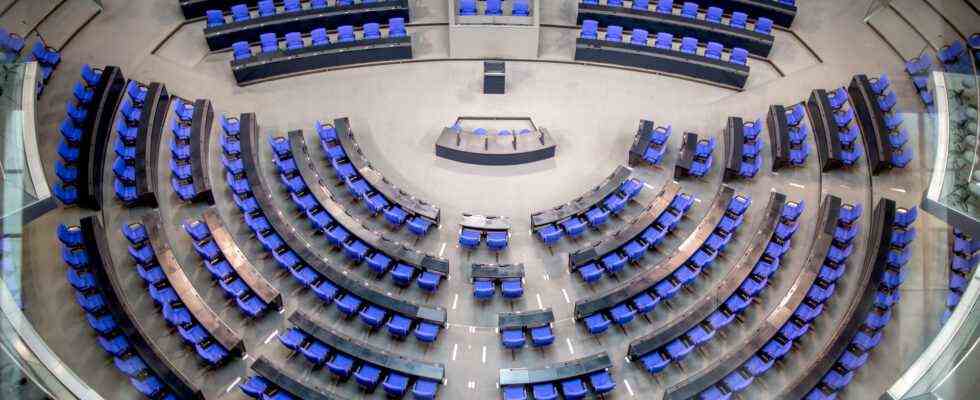FAQ
Status: 17.09.2021 5:01 p.m.
The heart of democracy is bursting at the seams: More and more members of parliament are sitting in the Bundestag – despite all the reforms of the electoral law. Why is that? How are the seats distributed? And is there now a threat of an XXL Bundestag?
Norbert Lammert – failed, Wolfgang Schäuble – failed: Two Bundestag presidents have already tried in vain to achieve an electoral reform that prevents the Bundestag from getting bigger and bigger. In the 2017 election, 78 members were added, increasing the parliament to 709 elected officials. In the vote on September 26, the parliament is likely to become even larger, according to experts – possibly even significantly. Why is that? And where should all the MPs be accommodated? An overview:
How are the seats distributed among the parties?
The Federal Republic of Germany is divided into 299 constituencies of almost the same size, from which a directly elected member or a directly elected member is sent to the Bundestag.
The decisive factor for the strength of the parties in parliament, however, are the second votes. Before the election, the parties draw up lists of candidates in all federal states. These will fill a further 299 seats in the Bundestag based on the results of the second vote.
Then why are there more than 598 MPs?
The fact that the Bundestag exceeds its target size is related to the so-called overhang mandates. They arise when a party in a federal state wins more direct mandates than it is entitled to after the second votes. These additional mandates already existed in the first federal election in 1949, but since reunification the number has increased significantly against the background of changes in the party landscape.
And why also compensation mandates?
Most recently, the Union has benefited from the overhang mandates (43 out of 46 overhang mandates in 2017), while smaller parties suffered a disadvantage due to the distortion of the second vote result. The Federal Constitutional Court therefore declared the current electoral law to be unconstitutional.
As a solution, a reform was passed in 2013 with which a compensation mechanism was introduced: The total number of seats in the Bundestag will be increased until the size ratio of the parliamentary groups corresponds again to the second vote result despite the overhang mandates. But that leads to an even higher number of MPs. In 2017 there were already 65 compensation mandates.
Wasn’t there another reform last year?
Yes, but only a small one. It was decided in autumn 2020 after a tough struggle with the votes of the Union and the SPD. As a result, three overhang mandates will no longer be compensated for in the future. In addition, further overhang mandates are to be offset to a limited extent with list mandates from the same party in other federal states.
From 2024 onwards, the number of constituencies will also be reduced from 299 to 280, which should reduce the number of overhang and compensatory mandates.
For critics, this reform does not go far enough. And Bundestag President Schäuble also emphasized: “Despite the investment of a lot of effort and patience and even more time and energy, all attempts to achieve an effective reform have failed. For me, this is one of the greatest disappointments of this legislative period.” So now the next Bundestag inherits the mammoth task of comprehensively reforming the electoral law.
So how big is the new Bundestag?
That depends on the actual voting behavior – also on whether many citizens distribute their first and second votes to different parties. The Bertelsmann Foundation has a mandate calculator different scenarios based on current survey trends. Accordingly, an “XXL Bundestag” is also possible. “
“The range of plausible possible Bundestag sizes runs from around 650 to more than 1000. That cannot be ruled out,” says Robert Vehrkamp, an expert on electoral law at the Bertelsmann Foundation. Much will depend on whether and how the voters split the first and second votes.
Will there be enough space for the MPs?
The Bundestag administration is keeping a low profile on possible plans to accommodate additional elected officials. A large extension will not be finished until 2022. There is no exact date. Another building made of prefabricated wooden modules should be ready in December of this year. But the offices would actually be needed weeks in advance because the new Bundestag must meet for the first time on October 26th at the latest.
Bundestag President Schäuble had already said in 2019 before the reform of the electoral law that his administration had “applied for an approval procedure for the construction of office containers” to be on the safe side. If necessary, more than 800 MPs and employees should be able to be accommodated. The Bundestag administration does not want to comment on this before the election on September 26th.
What are the costs for the additional MPs?
The taxpayers’ association has published estimates for the next four years. According to this, the parliament already costs 333 million euros more with the current size of 709 representatives than with the regular size of 598 elected representatives. With 800 members it would be an additional 605 million euros and with 900 seats it would be 905 million euros more.
More serious, however, is that the size of Parliament has an enormous impact on its ability to work and politics. Cross-party concerns are concerned about the functionality of parliamentary work, especially in the committees.
With information from AFP and dpa

